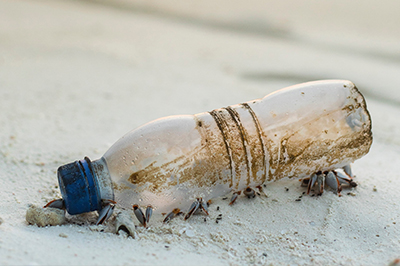Better recycling with plastic hungry enzymes

Summary
Household plastic waste is an increasing global problem as the annual supply of new plastics greatly outweighs their rate of biodegradation or recycling. Discovery of a new enzyme from plastic-eating bacteria, may hold the key for improving plastic recycling and reducing the amount of plastic waste in our environment.
A PET Project
Polythylene terphthalate, or PET, is the hard plastic that makes up our food containers, plastic bottles, and synthetic fibers. While you and your family probably know it’s important to recycle empty water bottles, what you might not know is where the bottle came from and what happens to it after it lands in a big blue bin.
The United States produces about 35,000 tons of new PET plastic per year (1). Only about 10% of that new production is recycled, which means that thousands of tons of plastic are sent to landfills every year (1). But this situation is not unique to the United States. New production of plastic waste from PET far outpaces recycling capacity world-wide.
Learning a recycling lesson from bacteria
In 2016, a team of researchers in Japan isolated a novel bacterial species from a plastic bottle recycling site (2). They found that the bacteria, called Ideonella sakaiensis, could convert PET to energy in a matter of days (3). This was exciting because PET generally takes hundreds of years to biodegrade. Scientists grew the new bacteria in the lab and studied which enzymes it uses to break down the plastic. Enzymes are like little molecular machines inside cells. They are usually made out of protein, and they help cells perform essential tasks like metabolizing fuel for energy, copying DNA, and even making more enzymes.
The plastic-eating enzyme found in I. sakaiensis converts a full PET molecule into its simple building blocks, which are not harmful to the environment (3). This function of the enzyme PETase is especially useful because current recycling technology for PET isn’t really true recycling (2). The plastic material changes structure through the process but is never fully recycled to its original form. For example, a PET plastic water bottle can be recycled into synthetic fabrics for clothing, and then maybe fibers for carpeting, but the PET will eventually end up in a landfill (2). Recycling with PETase closes the loop; hard plastic all the way back to hard plastic.
Future outlooks for plastic waste and recycling
After the initial discovery of PETase, scientists wanted to know how the enzyme worked and how to use genetic engineering to make it even better at degrading plastics (4, 5). In fact, a team based at the University of Portsmouth in the UK, engineered a PETase mutant enzyme in 2018 that just happened to greatly outperform the natural enzyme at degrading PET (5). The team concluded that PETase has lots of potential to be optimized for more efficiency.
Unfortunately, development of an enzyme system for plastic recycling is still far from being implemented on a large scale. Some of the biggest challenges include the costs and scale of producing enough PETase for industrial use (2). But this field is moving fast, and researchers and start-ups alike are working on improving PETase and other creative ways to rapidly biodegrade PET (6).
References
- Plastics: Material Specific Data. EPA (2018). Retrieved from https://www.epa.gov/facts-and-figures-about-materials-waste-and-recycling/plastics-material-specific-data.
- Halton, M. Recycling hope for plastic-hungry enzyme. BBC News (2018). Retrieved from https://www.bbc.com/news/science-environment-43783631
- Yoshida, S., Kiraga, K., Takehana, T., et al. A bacteria that degrades and assimilates ply(ethylene terephthalate). Science, 351(6278) 1196 - 1199. (2016). Retrieved from https://science-sciencemag-org.oca.ucsc.edu/content/351/6278/1196
- Joo, S., Cho, I.J., Seo, H. et al. Structural insight into molecular mechanism of poly(ethylene terephthalate) degradation. Nat Commun 9, 382 (2018). https://doi.org/10.1038/s41467-018-02881-1
- Austin, H. P., Allen, M. D., Donohoe, B. S. et al. Characterization and engineering of a plastic-degrading aromatic polyesterase. PNAS 115(19) E4350 - E4357. https://www.pnas.org/content/115/19/E4350
- Guy, J. Scientists create ‘super enzyme’ that eats plastic bottles six times faster. CNN world (2020). Retrieved from https://www.cnn.com/2020/09/29/world/plastic-eating-super-enzyme-scli-intl-scn/index.html
- Most Viewed Blog Articles (5)
- Company News (285)
- Emerging Technologies (64)
- Microbiology and Life Science News (93)
- Water and Fluid Separation News (97)
- Filtration Resources (93)
- Product News (19)


![Join Sterlitech at BIO 2024 [Booth #5558]: Exploring the Future of Biotechnology](https://www.sterlitech.com/media/blog/cache/300x200/magefan_blog/b4.jpeg)



